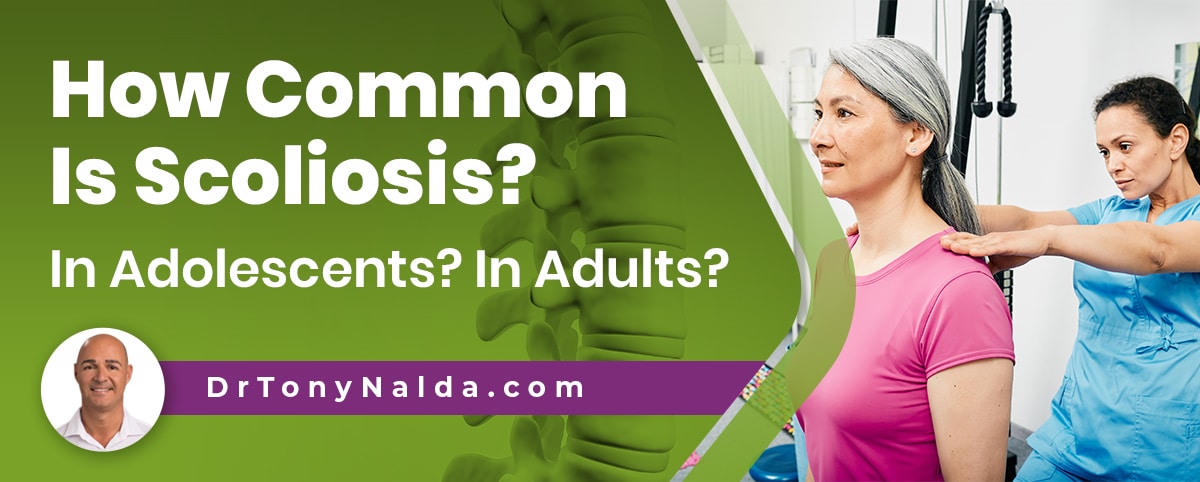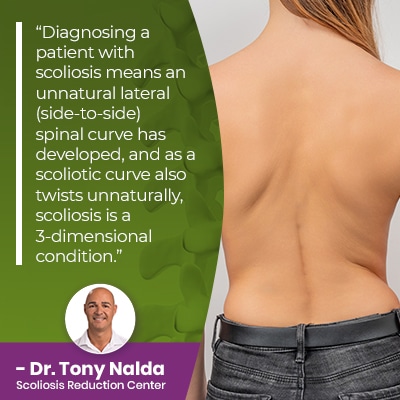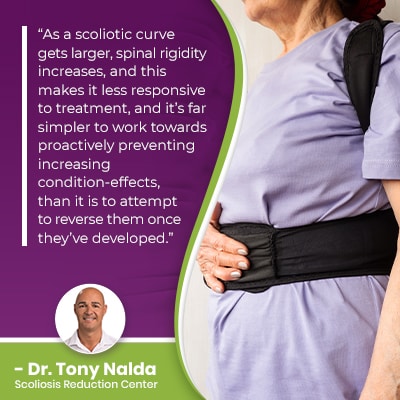How Common Is Scoliosis? In Adolescents? In Adults?

Scoliosis ranges widely in severity, has different condition types, and can affect all ages, but how common is it? Scoliosis is most commonly diagnosed in adolescents between the ages of 10 and 18 as adolescent idiopathic scoliosis (AIS), but it also affects adults; in fact, the actual rate of scoliosis increases with age.
While most people have heard of scoliosis, many don’t realize just how prevalent it is. Current estimates have close to seven million people living with scoliosis in the United States alone, and it is the most-prevalent spinal condition amongst school-aged children.
Scoliosis awareness is important because it can help lead to early detection and intervention, so let’s start with how scoliosis is diagnosed.
Table of Contents
Diagnosing Scoliosis
Scoliosis involves a loss of the spine’s healthy curves, and these curves are important because they help keep the spine aligned, make it stronger, more flexible, and better able to handle mechanical stress.
There are a number of spinal conditions that involve a loss of its healthy curves (kyphosis and lordosis), but scoliosis has some characteristics that set it apart from the rest and make it more complex to diagnose and treat.
 Diagnosing a patient with scoliosis means an unnatural lateral (side-to-side) spinal curve has developed, and as a scoliotic curve also twists unnaturally, scoliosis is a 3-dimensional condition.
Diagnosing a patient with scoliosis means an unnatural lateral (side-to-side) spinal curve has developed, and as a scoliotic curve also twists unnaturally, scoliosis is a 3-dimensional condition.
In addition, as a progressive condition, scoliosis has it in its nature to worsen over time, so where a scoliosis is at the time of diagnosis doesn’t always indicate that’s where it will stay; only proactive treatment can work towards counteracting the condition’s progressive nature.
Scoliosis ranges in severity from mild to moderate and severe to very severe, and this is also the condition’s progressive line.
Condition-severity is classified based on a measurement known as Cobb angle, and this is determined during X-ray by drawing lines from the tops and bottoms of the curve’s most-tilted vertebrae; the resulting angle is expressed in degrees.
What’s important to know about diagnosing scoliosis is that although it’s incurable, it can be highly treatable, but that will depend on a number of important factors, including the chosen treatment approach.
Now, let’s move on to address some important condition characteristics, including who it affects and the age group most commonly diagnosed with scoliosis.
What Age Does Scoliosis Affect?
Scoliosis is often described as a complex condition to treat, and there are several reasons for this: its progressive structural nature, its many different types, and that it can affect all ages.
The most common type of scoliosis is classified as idiopathic, meaning not clearly associated with a single-known cause, and this accounts for approximately 80 percent of known diagnosed cases, and the remaining 20 percent are associated with known causes: neuromuscular scoliosis, degenerative scoliosis, and congenital scoliosis.
While we don’t know what causes the majority of scoliosis cases to develop, we do know what triggers progression: growth and development.
Scoliosis progressing means the size of the unnatural spinal curve is increasing, and this also increases the amount of uneven forces the spine, its surroundings, and the entire body are being exposed to.
While there are never treatment guarantees, when scoliosis is diagnosed early and responded to with proactive treatment, there are fewer limits to what can be achieved.
 As a scoliotic curve gets larger, spinal rigidity increases, and this makes it less responsive to treatment, and it’s far simpler to work towards proactively preventing increasing condition-effects, than it is to attempt to reverse them once they’ve developed.
As a scoliotic curve gets larger, spinal rigidity increases, and this makes it less responsive to treatment, and it’s far simpler to work towards proactively preventing increasing condition-effects, than it is to attempt to reverse them once they’ve developed.
As scoliosis gets worse, its effects tend to become more noticeable, and in adolescents, the main symptom of scoliosis is postural deviation, and in adults, it’s pain, but how common is the condition in these age groups?
How Common is Scoliosis in Adolescents?
Scoliosis can affect all ages from babies as congenital scoliosis, infants as infantile scoliosis, juveniles as early-onset juvenile scoliosis, adolescents as adolescent idiopathic scoliosis, and adults who have reached skeletal maturity.
Adolescent idiopathic scoliosis is diagnosed in adolescents between the ages of 10 and 18, and this is the age group that scoliosis is most commonly diagnosed in, and considering the condition’s main trigger for progression, this is understandable.
Adolescents are at risk for rapid-phase progression because of the stage of puberty, characterized by rapid and unpredictable growth spurts, they are in, or are entering into.
The prevalence of scoliosis in adolescents is estimated at 1 to 3 percent, and scoliosis is more commonly diagnosed in females; this is thought to be related to puberty (growth and development) tending to start earlier in females, than in males.
And what about adults, how prevalent is scoliosis amongst adults?
How Common is Scoliosis in Adults?
While scoliosis is more commonly diagnosed during adolescence, the condition does affect adults.
The two main forms to affect adults are idiopathic and degenerative.
Cases of idiopathic scoliosis in adults show the importance of early detection, and the challenges of it, because these cases were adolescents with scoliosis who didn’t receive a diagnosis or treatment until adulthood; this is a common scenario because adolescent idiopathic scoliosis isn’t always easy to detect, particularly when mild.
Prior to reaching skeletal maturity in adulthood, the spine experiences a constant lengthening motion during growth, and that lengthening motion counteracts the compressive force of the scoliotic curve.
Compression (uneven forces) of the spine and its surrounding muscles and nerves is the main cause of condition-related pain, so in children for whom the condition is not yet compressive, pain isn’t a common symptom, making it hard to diagnose.
In addition, the postural changes that accompany scoliosis in children can be subtle and difficult for anyone, other than a specialist, to notice, and this is why so many adolescents go through puberty with scoliosis unaware, and it’s not until skeletal maturity is reached that the condition becomes painful and noticeable enough to bring them in for a diagnosis and treatment.
The unfortunate reality is that had these cases been detected early and treated during adolescence, they would be in far better shape than by the time they come to see me.
Scoliosis only gets more complex and challenging to treat as it progresses.
Degenerative Scoliosis
After idiopathic scoliosis, degenerative scoliosis is the next most common type to affect adults, and this is caused by natural age-related spinal degeneration that, most often, involves the spine’s intervertebral discs deteriorating.
Now, the interesting thing about adult scoliosis is that although the condition is most commonly diagnosed during adolescence, the actual rate of scoliosis increases with age, and this is because as the population ages, natural age-related spinal degeneration comes into play, increasing the rate of scoliosis diagnosed in adults over 50.
In fact, studies looking at the prevalence of scoliosis in adults indicate rates of between 12 and 20 percent, with one study, looking at the prevalence of scoliosis in otherwise healthy adults over 60, detecting a rate of 68 percent.
What these studies reveal is that while scoliosis is more commonly regarded as a child and/or adolescent condition, the actual rate of scoliosis is higher in adults as it increases with age.
Conclusion
So how common is scoliosis? The Scoliosis Research Society puts current estimates at close to seven million people living with the condition in the United States alone, but I want to remind readers that this is only an estimate because, of course, we don’t know how many people are living with the condition unaware.
Scoliosis accounts for approximately 20 percent of all spinal conditions in the United States, is the leading spinal condition amongst school-aged children, causing approximately 400,000 annual doctors visits, more than 133,000 hospital visits, and 17,000 emergency room visits.
So as you can see, scoliosis is a highly-prevalent spinal condition, making awareness important because it can lead to early detection and intervention, which increases the likelihood of treatment success.
Here at the Scoliosis Reduction Center, regardless of age or severity, I respond to a diagnosis of scoliosis proactively, by starting treatment as soon as possible.
By integrating multiple treatment disciplines into a proactive treatment plan, I can work towards impacting conditions on every level, and this includes condition-specific chiropractic care, physical therapy, corrective bracing, and rehabilitation.
Scoliosis is common, so common that at one time, mandatory scoliosis screening was offered in schools across the United States, but that has since changed, shifting the onus of early detection onto the shoulders of patients themselves; this is why spreading awareness is so important to me because, ultimately, it can help my patients achieve the best possible quality of life.
Dr. Tony Nalda
DOCTOR OF CHIROPRACTIC
After receiving an undergraduate degree in psychology and his Doctorate of Chiropractic from Life University, Dr. Nalda settled in Celebration, Florida and proceeded to build one of Central Florida’s most successful chiropractic clinics.
His experience with patients suffering from scoliosis, and the confusion and frustration they faced, led him to seek a specialty in scoliosis care. In 2006 he completed his Intensive Care Certification from CLEAR Institute, a leading scoliosis educational and certification center.
About Dr. Tony Nalda
 Ready to explore scoliosis treatment? Contact Us Now
Ready to explore scoliosis treatment? Contact Us Now





